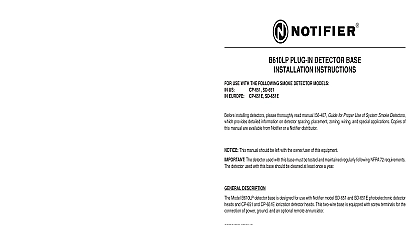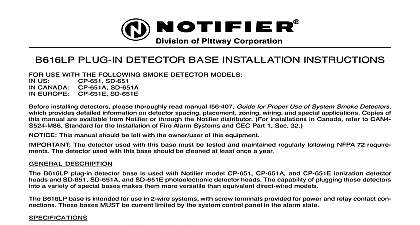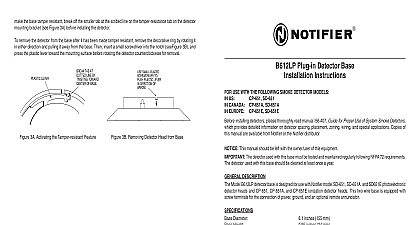Notifier B710LP and B710LPA Installation Instructions

File Preview
Click below to download for free
Click below to download for free
File Data
| Name | notifier-b710lp-and-b710lpa-installation-instructions-1725890463.pdf |
|---|---|
| Type | |
| Size | 977.77 KB |
| Downloads |
Text Preview
REMOTE ANNUNCIATOR MODEL RA400Z remote annunciator is connected between terminals 1 and 3 using the spade lug terminal packed with the remote The spade lug terminal is connected to the base terminal as shown in Figure 5 is not acceptable for three stripped wires to be under the same wiring terminal unless they are separated by a or equivalent means The spade lug supplied with the model RA400Z is considered an equivalent means See 5 for proper installation WIRE WITH LUG 5 Connection to Remote Annunciator Terminal Plug in Detector Base Instructions installing detectors please thoroughly read the system wiring and installation manuals and manual System Detectors Application Guide which provides detailed information on detector spacing placement zoning and applications Copies of these manuals are available from Notifier DESCRIPTION B710LP base is a plug in detector base intended for use in a 2 wire intelligent system with screw terminals provided power and and remote annunciator connections Communication takes place over the power and lines TERMINALS REMOTE ANNUNCIATOR ANNUNCIATOR PROOF 1 Terminal Layout 6.1 inches 15.5 cm 4 inch square box 102 mm with or without plaster ring Min Depth 1.5 inches 38 mm 4 inch 102 mm Octagon Box Min Depth 1.5 inches 38 mm 3 1 2 inch 89 mm Octagon Box Min Depth 1.5 inches 38 mm Single Gang Box Min Depth 1.5 inches 38 mm Temperature Range 32 to 150 0 to 66 refer to insert for the Limitations of Fire Alarm Systems 4 I56 637 06R Notifier 1 I56 637 06R 12 Clintonville Rd Northford CT 06472 1653 203 484 7161 RATINGS includes Base and Detector Range 15 32 Volts DC Peak Current nominal 150 at 24 VDC Surge At Rated Voltage 1.5 mA sec Current nominal 6.5 mA at 24 VDC detector base mounts directly to 3 1 2 inch and 4 octagon boxes 4 inch square boxes with or without rings and single gang boxes To mount remove ring by turning it in either direction to unhook snaps then separate the ring from the base Install the to the box using the screws supplied with the junction and the appropriate mounting slots in the base Place ring onto base then turn in either direction until ring snaps in place see Figure 2 WIRING GUIDELINES wiring must be installed in compliance with the National Code and all applicable local codes and any requirements of the authority having jurisdiction the proper wire size The conductors used to con smoke detectors to control panels and accessory should be color coded to reduce the likelihood of errors Improper connections can prevent a system responding properly in the event of a fire wiring must be installed in compliance with the National Code and all applicable local codes and any requirements of the authority having jurisdiction the proper wire size The conductors used to con smoke detectors to control panels and accessory should be color coded to reduce the likelihood of errors Improper connections can prevent a system responding properly in the event of a fire signal wiring the wiring between interconnected it is recommended that the wire be no smaller AWG 18 However the screws and clamping plate in base can accommodate wire sizes up to AWG 12 The of twisted pair wiring or shielded cable for the power and loop is recommended to minimize the effects of ON NOT NOT 2 Mounting Detector to Box interference shielded cable is used the shield connection to and from the detector must be continuous by using wire nuts crimping soldering as appropriate for a reliable connection connections are made by stripping about 3 8 of insulation from the end of the wire use strip gauge molded in sliding the bare end of the wire under the clamping plate and tightening the clamping plate screw Do not loop wire under the clamping plate zone wiring of the detector base should be checked before the detector heads are installed in them The wiring be checked for continuity and polarity in the base and dielectric tests should be performed base contains a label to write the zone address and type of detector to be installed at that location This informa is important to set the address of the detector head that will later be plugged into the base and to verify the type for that location ANNUNCIATOR Do not loop wire under terminal 1 or 2 wire run to provide supervision of connections A OPTIONAL WIRING 3 Typical Wiring Diagram for 2 wire loop Do NOT use the tamper resistant capability if the XR2 or XR2B Removal Tool will be used Tamper Resistant Tab in the Detector Mounting Bracket can make the detector tamper resistant by making it nec to use a small screwdriver or similar tool to detach the detector from the base make the detector tamper resistant use needle nose pliers to break the smaller tab at the scribed line on the tamper tab Figure 1 shows the location of this tab on the detector mounting bracket remove the detector from the base after it has been made tamper resistant remove the decorative ring by rotating it in direction and pulling it away from the base Then insert a small screwdriver into the notch as indicated in Figure and press the plastic lever toward the mounting surface before rotating the detector counterclockwise for removal LEVER TAB AT LINE BY TOWARD OF BASE SMALL BLADED TO PLASTIC LEVER DIRECTION OF 4A Enabling the Capability 4B Removing the Detector from the Base 2 I56 637 06R 3 I56 637 06R


